How to clean a microwave with lemon — the natural cleaning hack you need to know, no scrubbing required
3 simple steps to loosen food splatters and banish grease
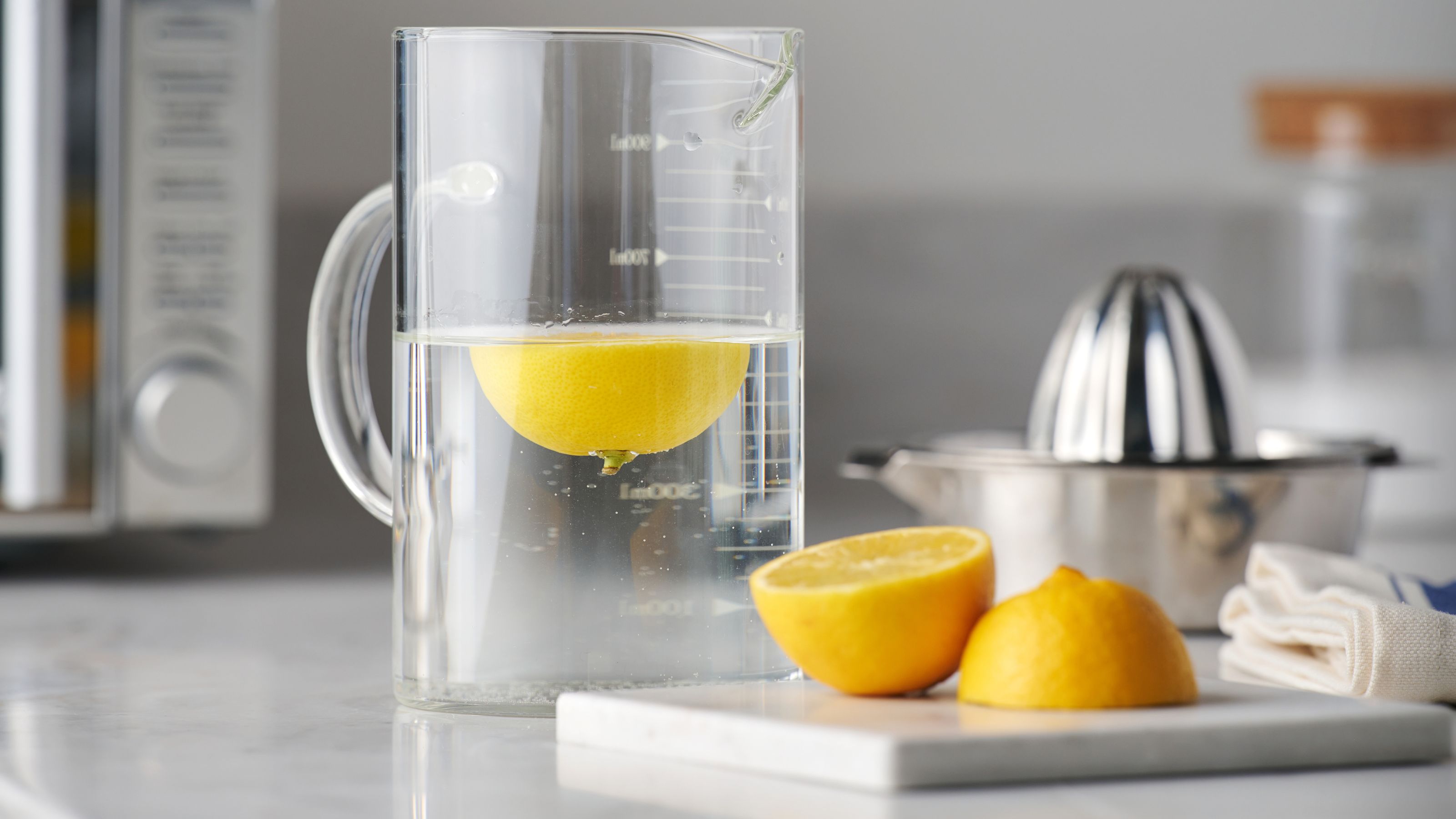

If you regularly add lemons to your shopping list (or your gin and tonic) and have spent the past few weeks ignoring the sorry state of your microwave, you’re in luck. With this handy fruit in tow, you can master how to clean a microwave with lemon in no time.
After all, the best microwaves can take a real battering. From splattered soup to crispy stray cheese and the lingering odours that you can’t quite place, it’s no wonder experts advise cleaning a microwave at least once a week. But most of us don’t have the time - or patience - to spend hours scrubbing away at these stains and dried-on food.
Thankfully, we don’t have to! If you nail how to clean a microwave with lemon, you can make the most of this non-toxic cleaning hack and let this natural degreaser and disinfectant do the hard work for you… no chemicals required.
What you'll need
- Cleaning cloths - like these Eco All Purpose Bamboo Cloths from Amazon
- Microwave-safe jug or bowl - like this 1 Litre Measuring Jug from Dunelm
- 1 lemons
- Water
Step-by-step
1. Squeeze lemon juice into a jug of water

Although you can just pop a lemon in your kettle and boil it when you want to clean a kettle with lemon, the same can’t be said for cleaning a microwave with this citric wonder. To give the natural cleaner the best chance of success, you need to cut a lemon in half and squeeze the juice into a microwave-safe jug or bowl.
This is echoed by Laura Harnett, founder of eco cleaning brand, Seep, who says, ‘Using a lemon to clean a microwave is highly effective, eco friendly and cheap. Slice a lemon in half and squeeze as much juice as you can into a cup of water. Pop the two lemon halves into the cup as well.’
You don't need to worry about the specifics when it comes to this step as you can ultimately never add too much lemon juice. So, just add as much as you can squeeze.
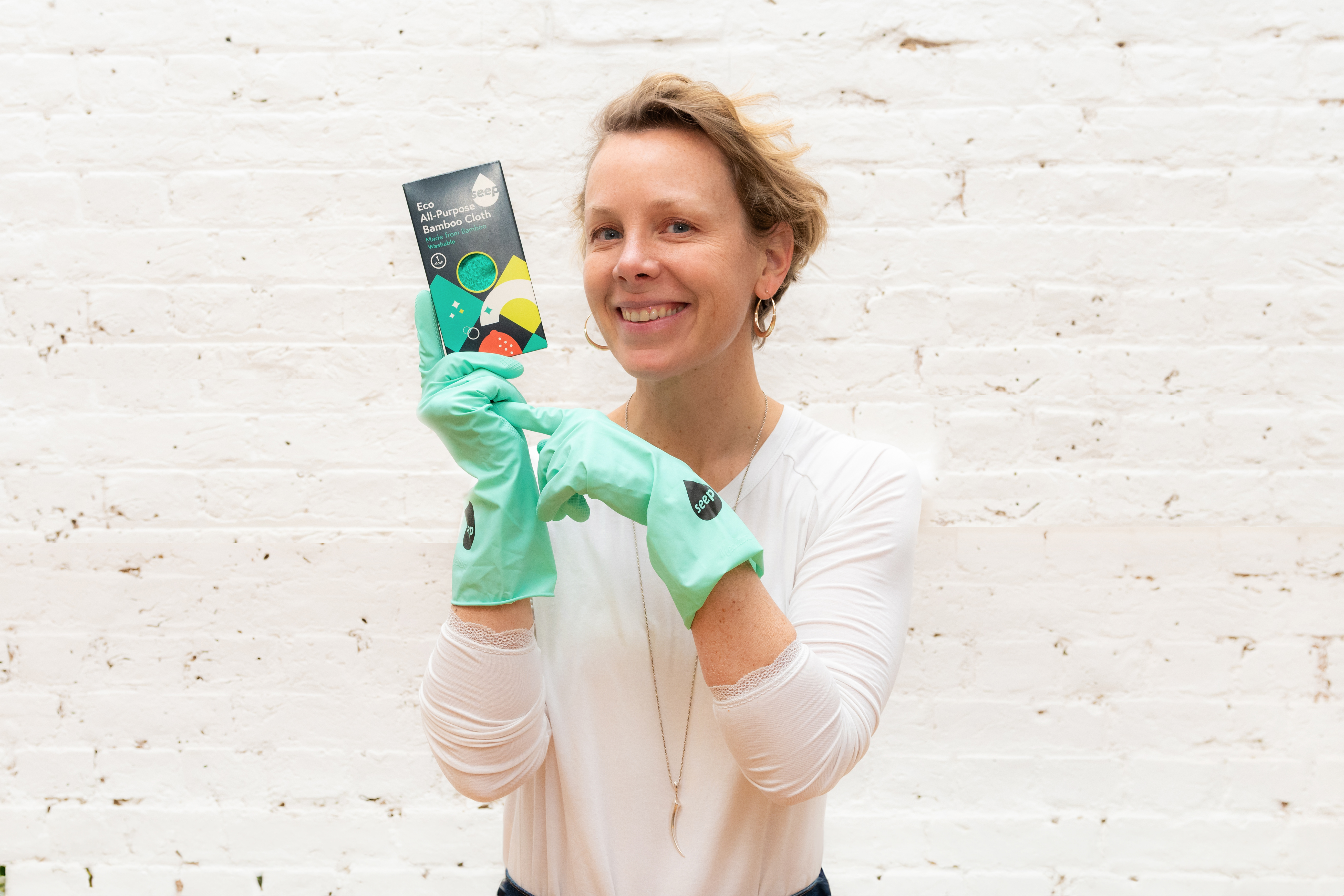
Laura Harnett is the founder of eco cleaning brand, Seep. She is determined to help as many people stop using unnecessary plastic as possible by encouraging them to switch to plastic free cleaning tools. She also recently appeared on Dragons’ Den and landed not one, but two Dragons to invest in her business.
2. Pop it in the microwave for three minutes
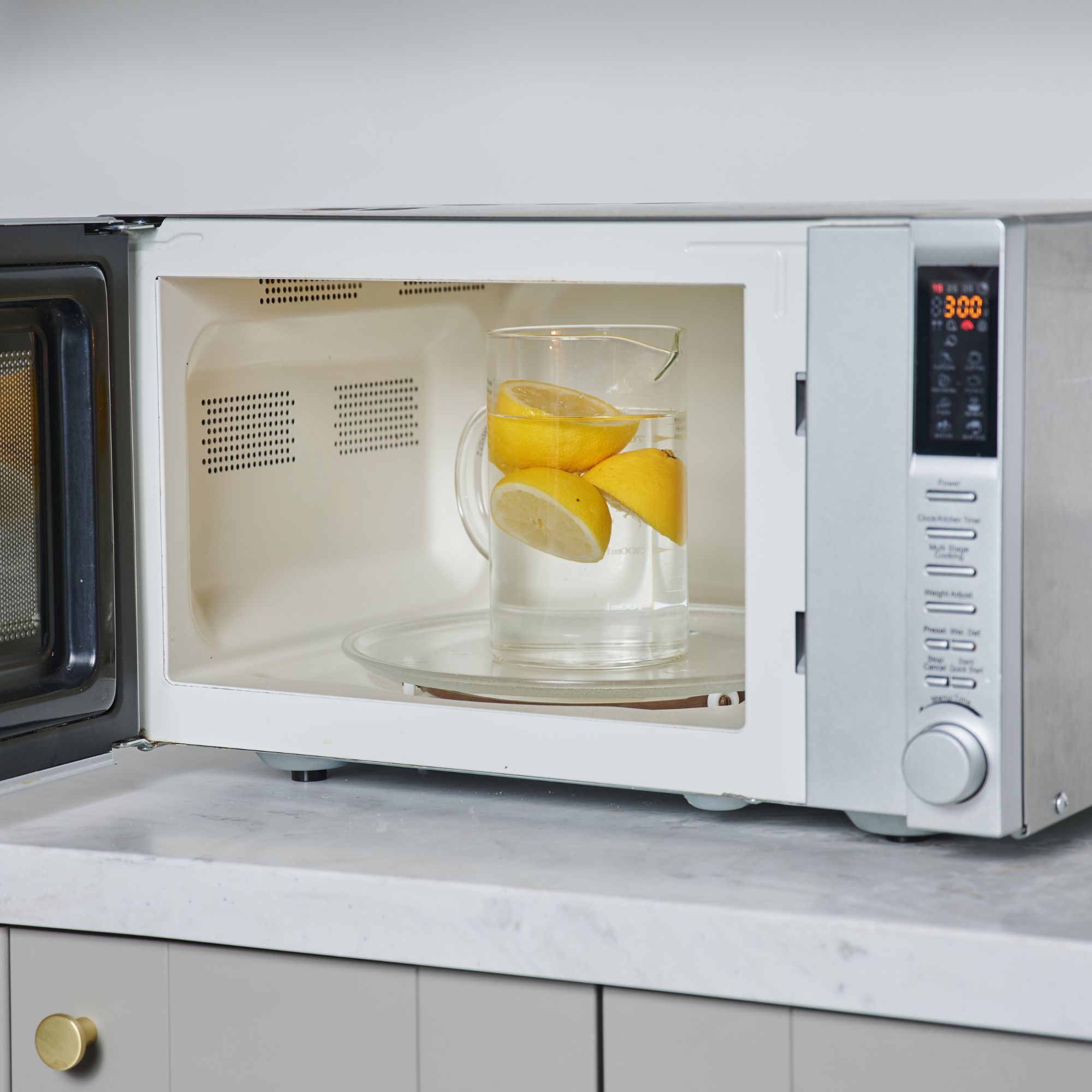
Then, place your jug of water onto the microwave plate and turn the appliance on. You should aim to heat it up on high for around three minutes, just until the water starts boiling - but not enough that it’ll overflow and cause an even bigger mess in your microwave.
Get the Ideal Home Newsletter
Sign up to our newsletter for style and decor inspiration, house makeovers, project advice and more.
This step will activate the lemon water steam to loosen grime and banish smells, but don’t be tempted to pull the jug out of the appliance immediately after the timer sounds.
Laura says, ‘Don’t open the door when the time is up, just leave it shut to let the steam work its magic as it will loosen any tough food stains and stubborn grease.’
3. Remove the jug and wipe down
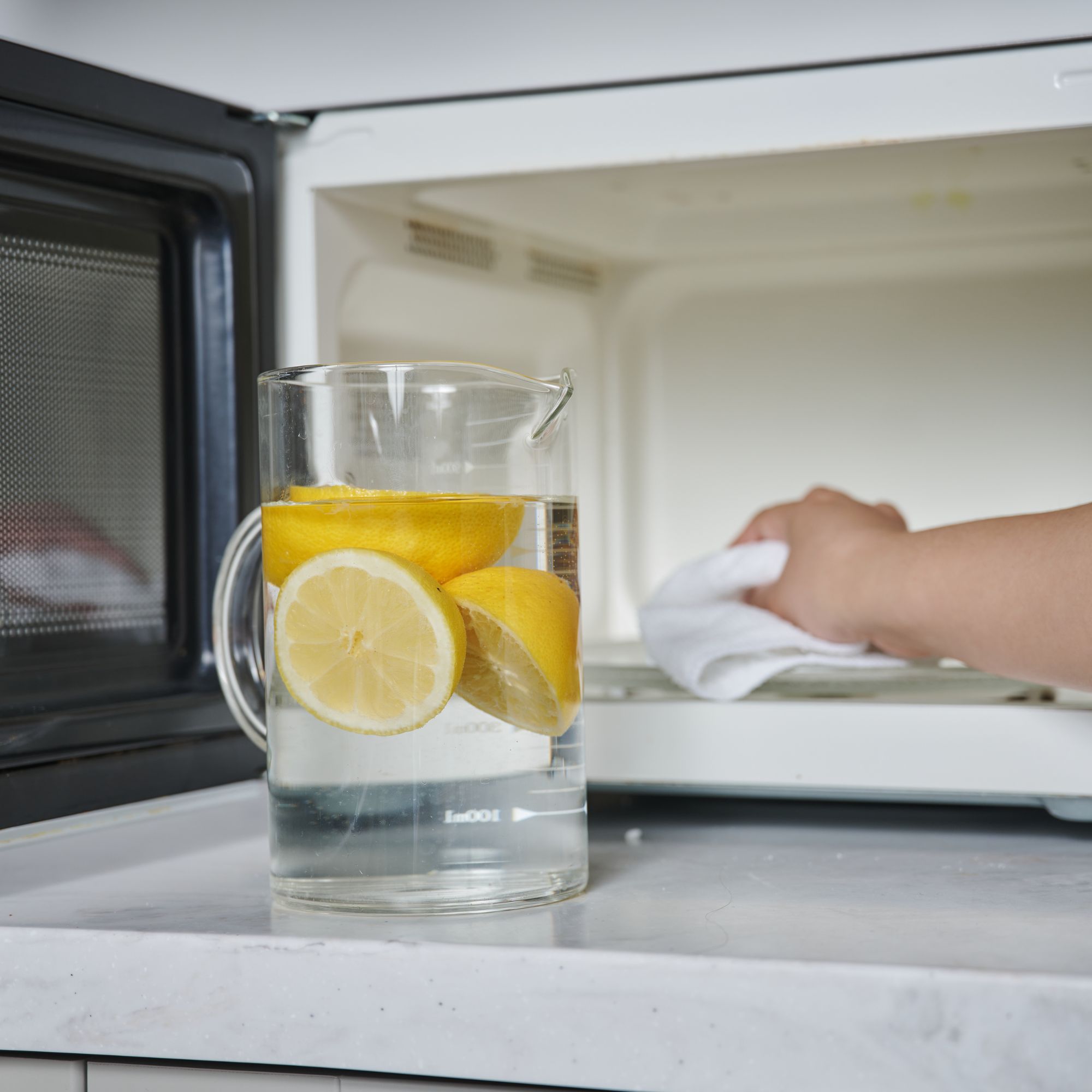
All in all, you should leave the jug of lemon water in the microwave for around five minutes before moving onto this next step. Then, you can grab a clean cloth and start cleaning - but you shouldn't need to scrub too hard.
Joyce French, cleaning expert at HomeHow.co.uk, says, ‘If the microwave has a turntable, remove this and give it a good wipe clean. Set this aside and then concentrate on wiping the inside of the microwave clean. Start with the ceiling and sides before cleaning the bottom.’
She adds, ‘If there are any stubborn spots of grime that don’t wipe away easily, dip your dish towel in the lemony water and scrub away until the spot is completely removed.’
If you have a microwave with plastic parts, this should leave your appliance sparkling clean and smelling fresh. But if you have a microwave with chrome parts, you can use the lemon halves for another task. In fact, if you wipe the lemon halves over the chrome parts, they’ll look shinier than ever.
FAQs
Is it better to clean microwave with lemon or vinegar?
Both lemon and vinegar can be extremely effective when cleaning a microwave, and both offer natural disinfectant qualities. However, there are some differences to consider depending on what you want from this cleaning process.
If you have a particularly greasy microwave and need a deeper clean but don’t mind a neutral scent afterwards, white vinegar is the option for you. If you just want to give your microwave an everyday clean but want it to smell fresh and citrusy, you should choose lemon.
Can you put a whole lemon in the microwave?
Yes, you can - but this won’t serve as a substitute for squeezing the juice into a jug of water to clean your microwave. But if you have unripe lemons and are struggling to extract the juice from them, putting a whole lemon in the microwave and heating it up for a few seconds can help you release the much-needed citric acid used for cleaning.
With this information in tow, you can clean your microwave in no time. But are there any other appliances you clean with lemons in your home?

Lauren Bradbury has been the Content Editor for the House Manual section since January 2025 but worked with the team as a freelancer for a year and a half before that. She graduated with a Bachelor’s degree in English and Creative Writing from the University of Chichester in 2016. Then, she dipped her toe into the world of content writing, primarily focusing on home content. After years of agency work, she decided to take the plunge and become a full-time freelancer for online publications, including Real Homes and Ideal Home, before taking on this permanent role. Now, she spends her days searching for the best decluttering and cleaning hacks and creating handy how-to guides for homeowners and renters alike, as well as testing vacuums as part of her role as the Ideal Home Certified Expert in Training on Vacuums, having spent over 110 hours testing different vacuum models to date!
You must confirm your public display name before commenting
Please logout and then login again, you will then be prompted to enter your display name.
-
 The herbs you should plant together for an easy-care herb garden – 6 expert-recommended combinations
The herbs you should plant together for an easy-care herb garden – 6 expert-recommended combinationsMake this year's herb garden effortless
By Sophie King
-
 IKEA has drenched its BILLY bookcase in this year’s ‘it’ colour - but you’ll have to act fast if you want to get your hands on one
IKEA has drenched its BILLY bookcase in this year’s ‘it’ colour - but you’ll have to act fast if you want to get your hands on oneI'm obsessed with this gorgeous limited-edition colourway
By Kezia Reynolds
-
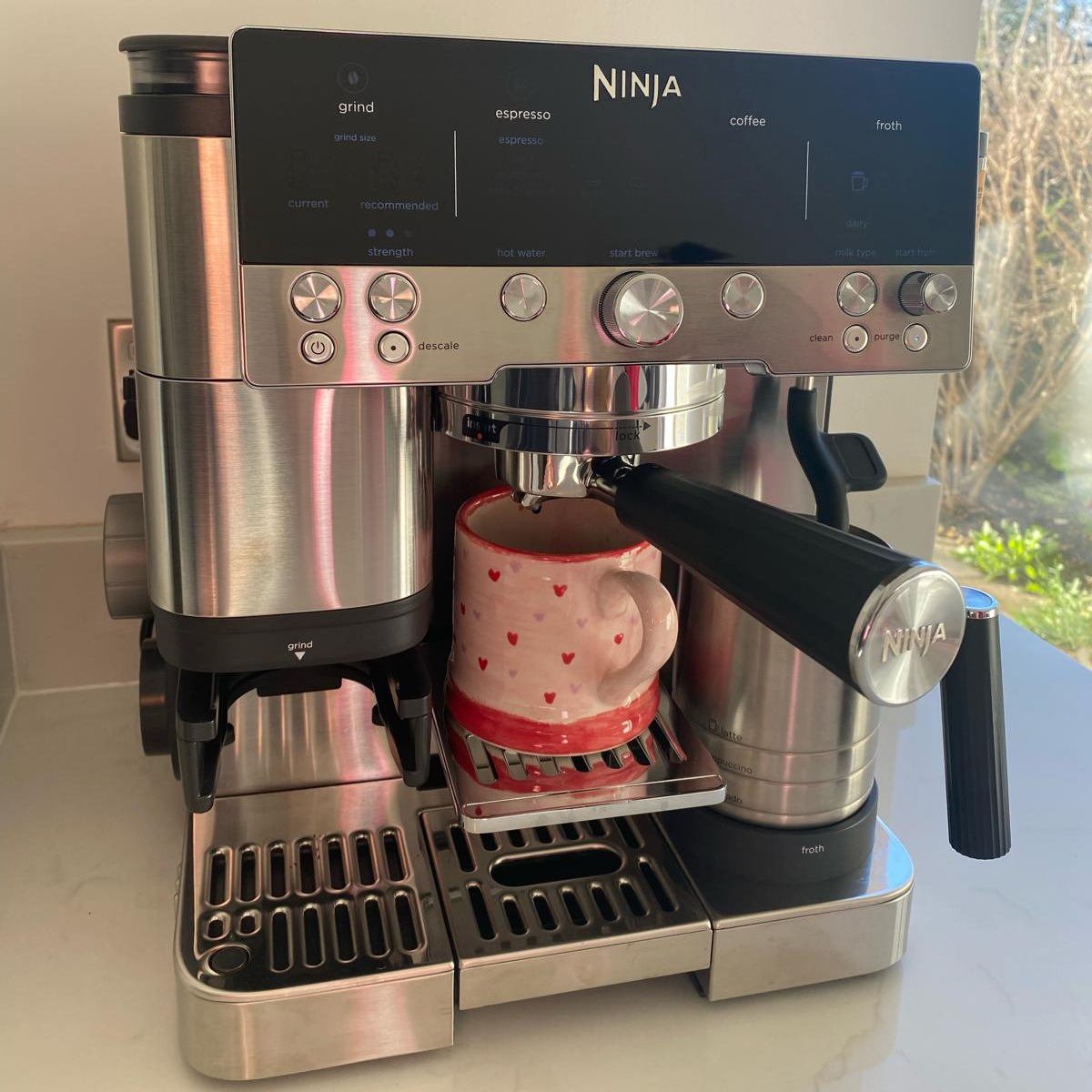 My go-to Ninja coffee machine is on sale for Easter weekend
My go-to Ninja coffee machine is on sale for Easter weekendIt makes coffee shop quality achievable at home
By Molly Cleary